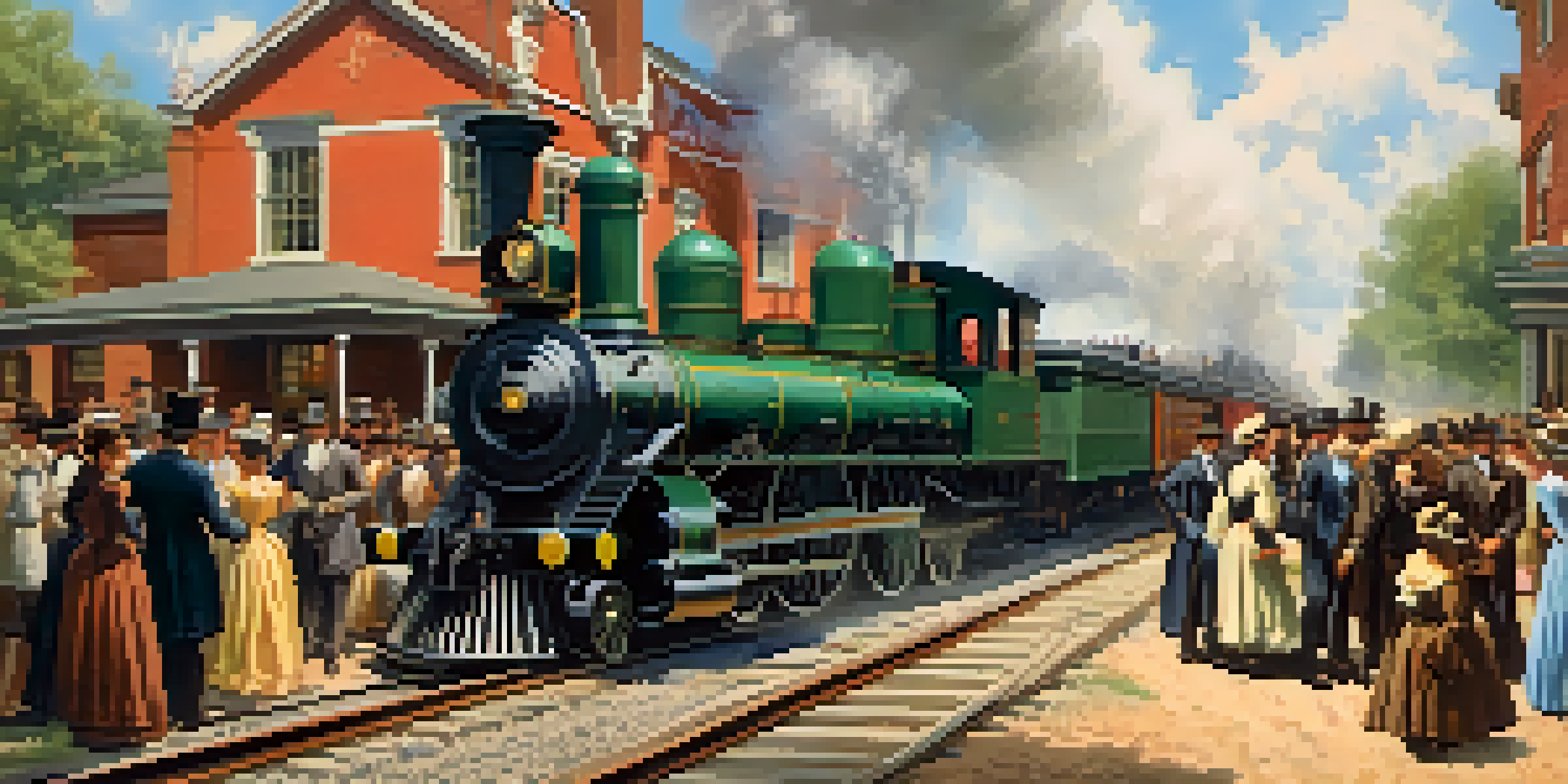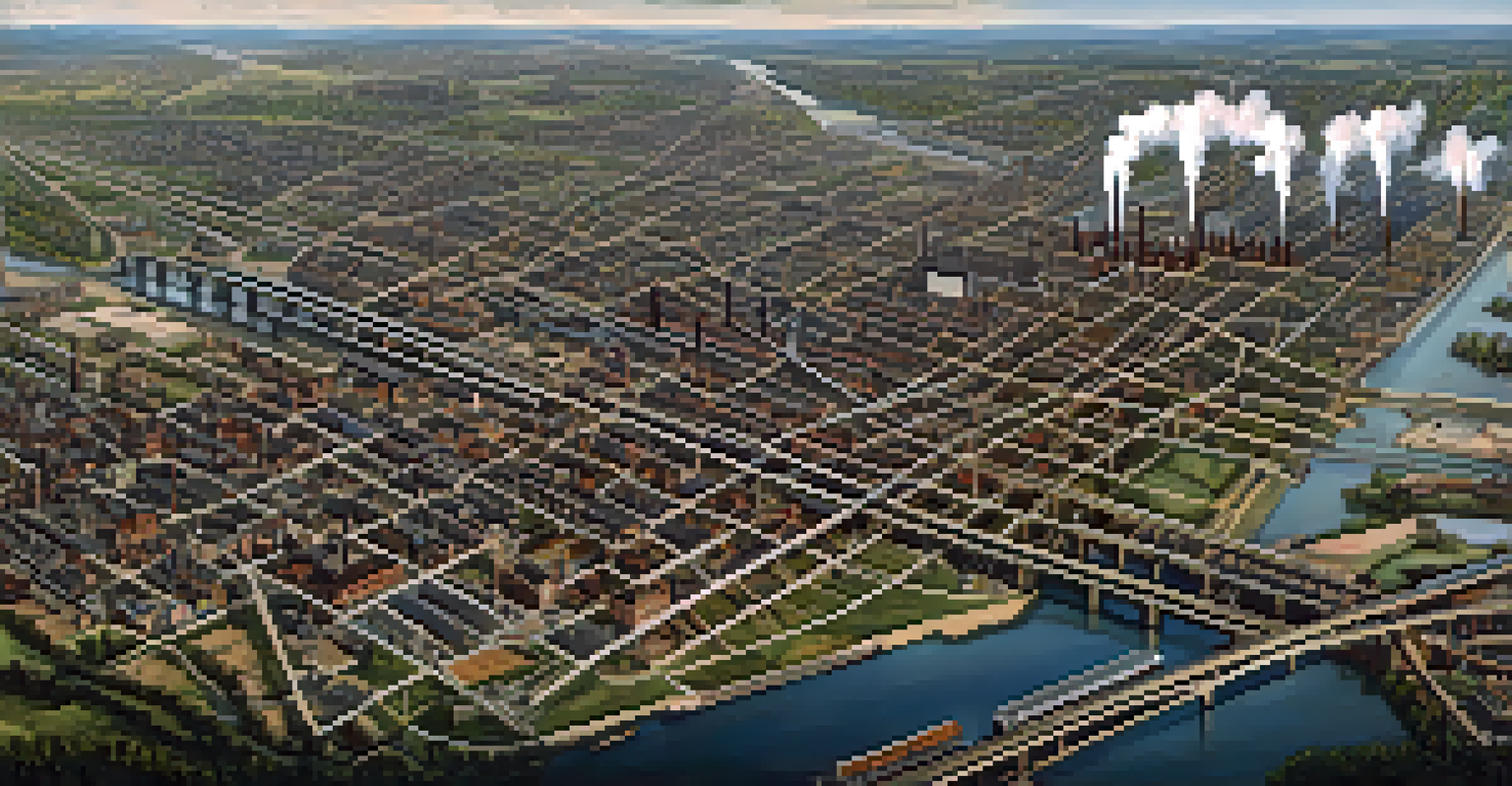The Impact of Railroads on Charlotte's Growth in the 19th Century

The Arrival of Railroads: A Game-Changer for Charlotte
In the 19th century, railroads emerged as a revolutionary mode of transport, reshaping cities across America. For Charlotte, the arrival of the first railroad in the 1850s marked a significant turning point. This new transportation network not only connected the city with larger markets but also attracted businesses and industries eager to capitalize on the easy access to goods and resources.
The railroads are a great boon to our commerce and the lifeblood of our cities.
Before railroads, Charlotte relied heavily on horse-drawn carriages and dirt roads, which limited trade and growth. The introduction of railroads allowed for much faster and more efficient movement of goods, leading to a surge in local commerce. This newfound connectivity positioned Charlotte as a pivotal hub in the Southeast, fostering economic development and urbanization.
The railroads also played a crucial role in shaping the social fabric of the city. As people from various regions flocked to Charlotte for economic opportunities, the city began to diversify. This influx of residents contributed to a more vibrant community, paving the way for cultural exchange and innovation.
Economic Expansion: Industries Thrive Along the Railroads
With railroads in place, Charlotte experienced substantial economic expansion in the 19th century. Industries such as textiles and manufacturing flourished, attracted by the ease of transporting raw materials and finished products. The city quickly became known for its textile mills, which relied on the railroads to distribute their products throughout the region and beyond.

As businesses grew, so did job opportunities for local residents. The railroads not only provided a lifeline for these industries but also attracted skilled workers from surrounding areas who were in search of better employment prospects. This influx contributed to a burgeoning middle class, which fueled further economic growth and development.
Railroads Boost Charlotte's Economy
The arrival of railroads in the 1850s transformed Charlotte into a commercial hub, facilitating faster trade and attracting industries.
Moreover, the presence of railroads encouraged the establishment of supporting infrastructure, such as warehouses and distribution centers. This laid the groundwork for a more organized economy, enhancing Charlotte's reputation as a commercial center in the Southeast.
Real Estate Boom: The Railroad's Influence on Land Values
As railroads expanded, so did the opportunities for real estate development in Charlotte. The increased accessibility attracted investors and developers who recognized the potential for profit in the booming city. Land values surged, particularly near railroad depots and stations, as people rushed to buy and develop property.
Transportation is the backbone of urban development, and railroads paved the way for cities to grow and thrive.
This real estate boom not only transformed the city's landscape but also influenced urban planning. Streets were designed to accommodate the influx of people and goods, with new neighborhoods sprouting up around key rail lines. The result was a more structured and connected city that catered to both residents and businesses.
Additionally, this growth led to the construction of new facilities, such as hotels and retail shops, further enhancing Charlotte's status as a thriving urban center. The railroads acted as a catalyst for this transformation, driving both economic and physical development.
Cultural Developments: Railroads Bring Diversity to Charlotte
The expansion of railroads in Charlotte not only influenced the economy but also enriched the city's cultural landscape. As people from different backgrounds arrived, they brought their traditions, cuisines, and customs, creating a melting pot of cultures. This diversity has played a vital role in shaping Charlotte's identity over the years.
Cultural institutions began to emerge, including theaters, museums, and music venues, reflecting the city's growing vibrancy. These establishments provided platforms for artistic expression and community engagement, further enhancing the quality of life for residents. Railroads facilitated not just the movement of goods, but also the exchange of ideas and cultural experiences.
Real Estate Boom Fueled by Railroads
Railroad expansion led to a significant increase in land values and urban development, reshaping the city's landscape.
Moreover, events such as fairs and festivals became more common as transportation improved. These gatherings not only celebrated the local culture but also fostered a sense of community among residents, strengthening ties and promoting collaboration across different groups.
Transportation Networks: Railroads Connect Charlotte to the World
The development of railroads significantly improved Charlotte's connectivity to the rest of the country. With multiple lines linking the city to major hubs, Charlotte became a critical junction for trade and travel. This connectivity opened the door for businesses looking to expand their reach and consumers seeking diverse products.
As trains provided efficient means of transportation, they also encouraged tourism, allowing visitors to explore Charlotte's attractions more easily. The city's appeal grew, drawing in potential residents and investors who saw the promise of opportunity. This influx of interest reinforced Charlotte's position as a prominent urban center.
The interconnectedness offered by railroads ultimately laid the groundwork for future transportation developments, including highways and air travel. As Charlotte continued to grow, the influence of railroads remained evident in the city's ongoing evolution as a transportation hub.
Challenges and Setbacks: The Impact of Railroad Expansion
Despite the many benefits brought by railroad expansion, challenges also arose during this transformative period. The rapid growth led to issues such as overcrowding and inadequate infrastructure in some neighborhoods. With the influx of people, the city struggled to keep pace with housing demands, resulting in substandard living conditions for many residents.
Additionally, the railroads contributed to social tensions, particularly around labor and race. As industries expanded, workers began to organize for better wages and working conditions. These movements sometimes clashed with the interests of railroad companies and local businesses, leading to conflicts that shaped the labor landscape in Charlotte.
Cultural Diversity Thrives with Railroads
The influx of people brought by railroads enriched Charlotte's cultural landscape, fostering a vibrant community with diverse traditions.
Environmental concerns also emerged as the railroads expanded their reach. The construction and operation of rail lines altered landscapes and ecosystems, prompting discussions about sustainability that are still relevant today. Balancing growth with environmental stewardship became an ongoing challenge for the city.
Legacy of Railroads: Lasting Impact on Modern Charlotte
The impact of railroads on Charlotte's growth in the 19th century is still felt today. The foundational changes initiated by the railroads set the stage for the city's development into a major financial and cultural center. Many of the industries that thrived during this period continue to play a significant role in the local economy.
Moreover, the city's commitment to transportation infrastructure has evolved from railroads to modern transit systems, ensuring that Charlotte remains well-connected. The lessons learned from the 19th-century railroad expansion inform current urban planning and development initiatives, emphasizing the importance of connectivity and accessibility.

Finally, the cultural diversity and community spirit fostered during the railroad era continue to enrich Charlotte's identity. The vibrant tapestry of cultures and traditions established during this time has paved the way for a dynamic, inclusive city that celebrates its history while looking toward the future.